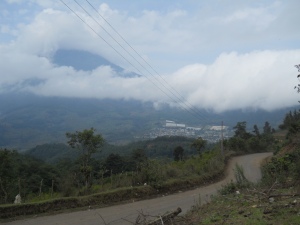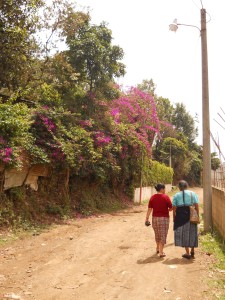The scene is set: 10:30 pm, dark, cold, and foggy as we leave a patient’s house; Doña Eulalia, 4’9” tall, 70 years old, with a large bundle of bledos (a local herb) tucked under her right arm, purse slung over her left shoulder leads. I offer her a light to better see the obscure path and she politely declines with a wave of her free hand. Together we scramble down a steep slope of loose dirt, startling chickens, startled by cows, and generally causing a stir among the odd dogs, pigs, and horses. We make it to the bottom, where the ambulance is waiting to give us a ride home.
The fog at this point offers maybe 3 meters of visibility, but that estimate sharply declines when they turn on their headlights and for some reason, the flashers. And so it is, after a 14 hour day seeing patients, we are barreling down a dirt road through time and space in a cotton-candy-cane whirl of red and white lights in the fog. Doña Eulalia and I look at each other and laugh, when all of a sudden the engine cuts out. Oh dear. We are still at least four kilometers from home. The driver leans his head back and groans and the other two bomberos (fireman/emergency workers) fling open their passenger side doors, grab on to the roof, and commence to rock the van with all their might. “It’s because we are out of fuel,” says the driver. Eulalia leans her head back and howls with laughter, “Ay pobrecitos!” she says. Suddenly, with the combined momentum of the boys rocking the van, the engine kicks in and we start ascending our hill again… All the while with the boys hanging out the open doors, undulating in rhythm to keep the van’s forward momentum. We carry on in that fashion for the next 15 minutes home, all the while with Eulalia’s laughter bubbling up like a spring. “Ay Sonia! Que vas a contar cuando vuelvas a Estados Unidos?! Este es loco!! Ahahah!” (Oh Sonia! What are you going to tell them when you go home?! This is crazy!). “I can’t make this stuff up!” I responded. We cracked up like this for some time, eventually having to pass our house to get to the bombero’s station or they would not have made it up the next hill. We get out to walk home. “How is it that the emergency workers are out of fuel? It seems like a rather important service…” I say. Eulalia shakes her head, “No, the state does not pay for their fuel, we will take them a gallon tomorrow.”
ear grin*.
To even begin to explain how we wound up in that ambulance at that hour, I first need to explain three things: 1- Where is Calderas? 2- How did I come to be in Calderas? And finally 3- Who is Doña Eulalia?
To answer the first question, here is a VERY primitive and largely incorrect map that is unfortunately the product of four drafts, too many questions, and too much time. It is an attempt to explain to myself where exactly it is that I have been riding around in truck beds and ambulances. It has been very foggy and thus extremely difficult to orient myself according to the many volcanoes, so my apologies if it is very wrong, but Calderas is approximately as shown here:
[please check back when I have time to actually upload my drawing… sorry!)
To answer the second: I arrived in Antigua last Monday, excited about my future in Calderas, but also a little nervous and unsure of what exactly I had signed up for. To be clear, everything that could be explained, had been explained. I am here through a non-governmental organization called Midwives For Midwives, or in Spanish, Comadronas Para Comadronas. The part of the organization that I am participating in is a homestay with a traditional midwife, no prior experience needed. With half a week down (out of four), it’s been pure magic. To find out more about the organization and what they do, (or to donate…) their website is a wealth of information, otherwise feel free to email me about my experiences here.
The third question is more to be answered over the next month, though even then I think a documentary would serve better than this silly little blog. Doña Eulalia is the traditional midwife with whom I have the great pleasure and honor of living with and learning from for a month. She is somewhere in her 70s and has been practicing as a midwife/health consultant for 35+ years. She lives in Calderas, Guatemala and has her entire life, and serves several communities in the surrounding area. However, for being from such a remote location, with little formal education, this woman is SHARP. She knows US geography and states better than most Europeans I have encountered. She remembers names and people’s hometowns and stories like they were her own. She has a tab on which countries in Europe still have royals. She owns large plots of land and grows her crops for export to El Salvador.
And all this on top of having seen – and knowing what to do about – just about everything that could ail a person. She is a master midwife with extensive knowledge of traditional herbal remedies. On my first day in the field with her I watched her flip a baby in-utero (to be head-down) in about 15 seconds with a pre-natal check-up. She makes house calls most of the week, but her door is always open. The people in her community come by at all hours of the day (or night) for check-ups, exams, questions, vitamins, antibiotics, Vitamin K injections, and a little gossip.
She loves her coffee, 4 times per day, if possible, picks flowers along her walks between villages, and knows all of her 34 grandchildren’s birthdays. She has seen more birth and death than I will ever know, and still attends each and every one of her patients with the same level of concern and compassion.
One such example led to our night-ride in the ambulance: We left the house about 9 that morning to hitch a ride to the neighboring pueblos for our house calls. After visiting a C-Section patient (4 days post op at that point), rubbing a few more uteruses, calculating a few dates, and catching up on the community news (births, pregnancies, and deaths), we arrived at a house in Chimachoy to do a routine check up on a woman 5 months pregnant. First thing in the door and Doña Eulalia takes a quick look at the 1 ½ year old at the woman’s hip and asks if she’s sick. The child is breathless, restless, and teary. Our patient told us that she had been to a nearby doctor a few days earlier who said some rest and fluids should do the trick. Eulalia furrows her brow, hands me her stethoscope, and asks if I can listen to the child’s lungs. Sure enough, the little girl has some gnarly crackles along with some wheezing. I report back and the consensus is that it’s time for a pediatrician. So Eulalia hops on her Nokia brick phone, makes a few calls, and lines up a doctor in Antigua that might be up to her standards. We spent a couple hours with the doctor, and thank god. The little girl was one untreated day away from an inpatient stay at the hospital in Antigua. The doctor herself was also a godsend in her patience and knowledge. The child received two nebulizer treatments in the clinic before the doctor sent the family with her clinic nebulizer, all free of charge. The whole visit cost 100 Q (about $13 USD), before the pharmacy visit.
At this segment I would like to point out that one of the reasons I trust the Doña so much is because she has incredibly high standards for other practitioners – which is why she usually accompanies her patients into Antigua, rather than using the closer community hospital, and does not hesitate to make referrals the moment she feels the need for a second opinion. We went in to Antigua with patients twice in two days so that she knew they were receiving appropriate care… Neither one of them paid a single Quetzal for her time or services those days.
I’m out of time for the moment, back to the rustic life, but stay tuned for more on The Dona, our clinical adventures, and life in rural Guatemala. Que le vaya Bien! In the meantime.



Dear Sonia,
I’m so glad that I live in Salem and can encounter you, be in your presence and share in the magical journey that you have woven so very wonderfully with words. You are gifted as a chronicler, effectively weaving together places visited, new lifelong friendships formed and this awakended breadth of perspective and worldview discovered through travel.
Now in Calderas with Dona Eulalia ; thus far, you’ve again transported your readers to your new “home”, introduced us to your mentor and are sharing and intriguing us this with this part to your story. We await the next edition!
Be well and safe,
Brada…..and Tom, too